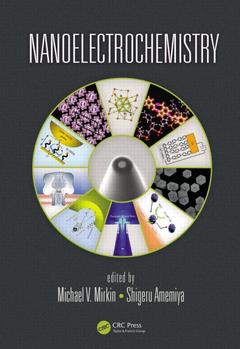Nanoelectrochemistry
Coordonnateurs : Mirkin Michael V., Amemiya Shigeru

Nanoscale electrochemistry has revolutionized electrochemical research and technologies and has made broad impacts in other fields, including nanotechnology and nanoscience, biology, and materials chemistry. Nanoelectrochemistry examines well-established concepts and principles and provides an updated overview of the field and its applications.
This book covers three integral aspects of nanoelectrochemistry. The first two chapters contain theoretical background, which is essential for everyone working in the field?specifically, theories of electron transfer, transport, and double-layer processes at nanoscale electrochemical interfaces. The next chapters are dedicated to the electrochemical studies of nanomaterials and nanosystems, as well as the development and applications of nanoelectrochemical techniques. Each chapter is self-contained and can be read independently to provide readers with a compact, up-to-date critical review of the subfield of interest. At the same time, the presented collection of chapters serves as a serious introduction to nanoelectrochemistry for graduate students or scientists who wish to enter this emerging field.
The applications discussed range from studies of biological systems to nanoparticles and from electrocatalysis to molecular electronics, nanopores, and membranes. The book demonstrates how electrochemistry has contributed to the advancement of nanotechnology and nanoscience. It also explores how electrochemistry has transformed itself by leading to the discovery of new phenomena, enabling unprecedented electrochemical measurements and creating novel electrochemical systems.
Theory of Nanoelectrochemistry. Electron Transfer in Nanoelectrochemical Systems. Electrochemical Double-Layer Effects on Electron Transfer and Ion Transport at the Nanoscale.Nanoelectrochemical Systems. Electrochemistry of Monolayer-Protected Clusters. Platinum-Monolayer Oxygen-Reduction Electrocatalysts: Present Status and Future Prospects.Photoelectrochemistry with Nanostructured Semiconductors. Single-Molecule Nanoelectronics. Electron Transport and Redox Reactions in Solid-State Molecular Electronic Devices. Stochastic Events in Nanoelectrochemical Systems.Nanoelectrochemistry of Carbon. Template-Directed Controlled Electrodeposition of Nanostructure and Composition. Nanopores and Nanoporous Membranes. Recent Investigations of Single Living Cells with Ultramicroelectrodes.Nanobioelectrochemistry: Proteins, Enzymes, and Biosensors. Electrode Array Probes of Exocytosis at Single-Cell Membranes and Exocytosis Measurements at Cell Biomimetic Systems. Nanoelectrochemical Methods. Nanoelectrodes and Liquid/Liquid Nanointerfaces. Microfabricated Electrochemical Systems. Electrodeposition at the Nanoscale. Scanning Electrochemical Microscopy of Nanopores, Nanocarbons, and Nanoparticles. Scanning Electrochemical Cell Microscopy: Mapping, Measuring, and Modifying Surfaces and Interfaces at the Nanoscale. In Situ Atomic Resolution Studies of the Electrode/Solution Interface by Electrochemical Scanning Tunneling Microscopy. Combined Atomic Force Microscopy–Scanning Electrochemical Microscopy. Nanoscale Potentiometry. Index.
Michael V. Mirkin is professor of chemistry at Queens College, City University of New York. His professional interests are in the application of electrochemical methods to solving problems in physical and analytical chemistry and include charge-transfer reactions at solid–liquid and liquid–liquid interfaces, electrochemical kinetics, and nanoelectrochemistry. He has published more than 110 peer-reviewed papers and book chapters and co-edited the first monograph on scanning electrochemical microscopy. He earned a PhD in electrochemistry (1987) from Kazakh State University (former USSR) and did postdoctoral research at the University of Texas at Austin from 1990 to 1993.
Shigeru Amemiya is associate professor in the Department of Chemistry at the University of Pittsburgh. He is the author or coauthor of more than 60 scholarly papers and book chapters in electroanalytical chemistry. His research interests are electrochemical sensing and imaging for biological and material studies, including the development of nanoscale scanning electrochemical microscopy and ultrasensitive ion-selective electrodes. He earned his BS (1993) and PhD (1998) in chemistry from the University of Tokyo, Japan, and received a postdoctoral fellowship from the Japan Society for the Promotion of Science to work at the University of Tokyo and the University of Texas at Austin.
Date de parution : 03-2015
17.8x25.4 cm
Date de parution : 12-2021
17.8x25.4 cm
Thèmes de Nanoelectrochemistry :
Mots-clés :
American Chemical Society; Tip Current; Theory of Nanoelectrochemistry; Ru NH3; Electrocatalysis on the nanoscale; SECM Tip; Nanoelectrodes and nanointerfaces; Redox Species; Nanoelectrochemical Systems; ORR Activity; Nanoelectrochemical Tools and Techniques; Potential Drop; nanoelectrochemistry; Nanoporous Membranes; electron transfer; Exocytotic Events; nanoelectronics; Tunnel Current; nanoscale; Fusion Pore; nanobioelectrochemistry; Fib Milling; Au144 Nanoparticles; SICM; SEM Image; Redox Mediator; Approach Curve; Electric Eld; EDL Effect; Electrode Surface; Resistive Pulse Sensing; Charge Carrier; SECM Image; SECM; Quantum Dot



